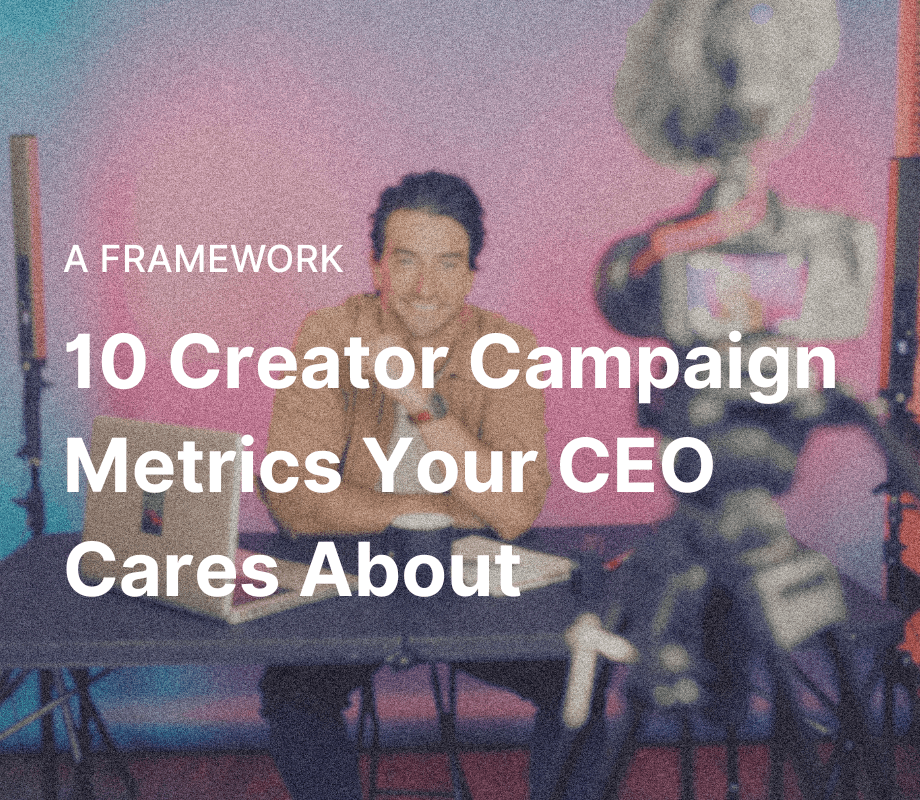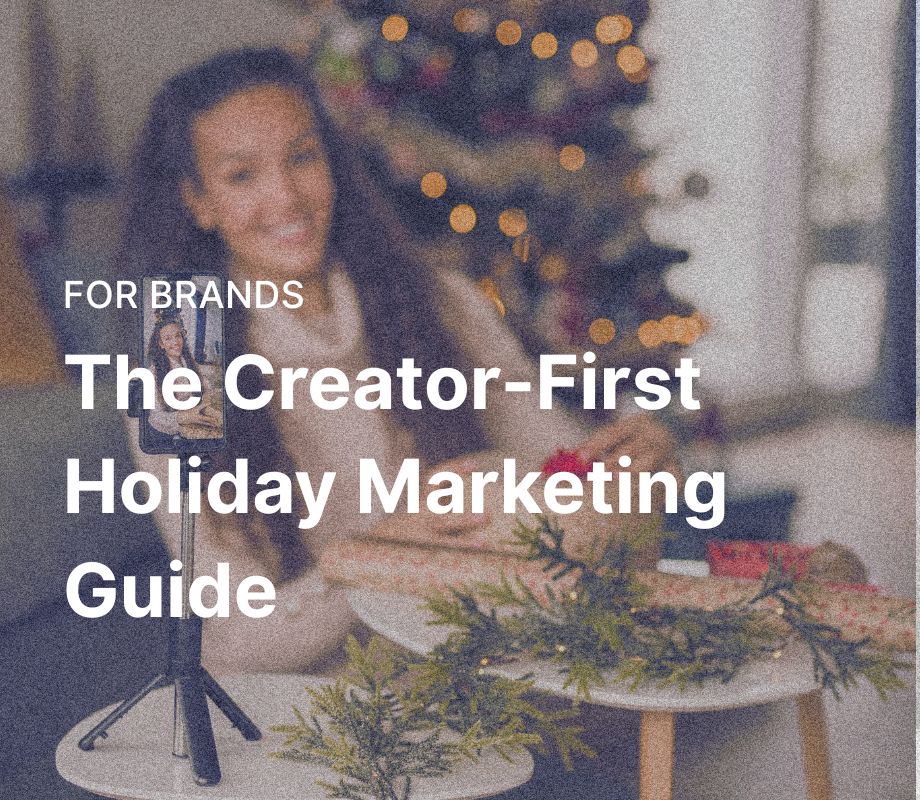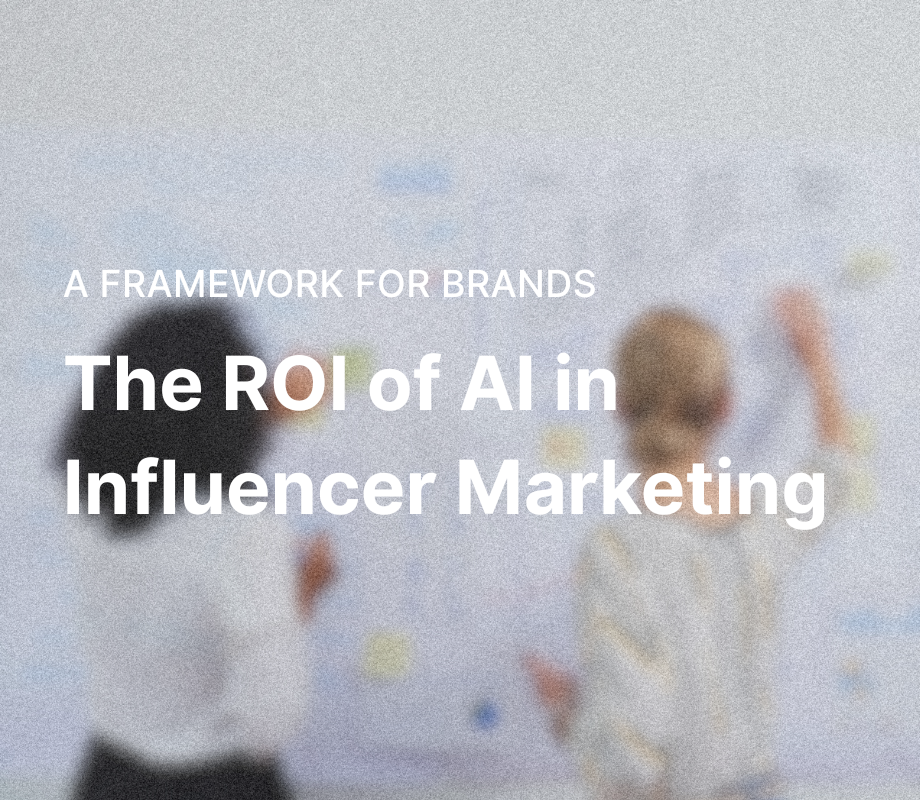TL;DR
54% of marketers cite reach as their top creator campaign metric, while 71% of CEOs want marketing to focus on sales and revenue. This disconnect is costing brands millions in misallocated budgets and missed opportunities.
The metrics that look impressive in slide decks are not the ones that drive business growth. Reach and impressions measure potential exposure, but conversion rates, customer acquisition costs, and lifetime value connect creator partnerships directly to revenue.
The brands building rigorous measurement frameworks now will scale their creator programs while competitors debate whether influencer marketing "works." This guide breaks down the 10 metrics that actually matter, when to use them, and how to build measurement infrastructure that proves ROI.
Table of Contents
Join over 1 million marketers to get social news, trends, and tips right to your inbox!
Email AddressWhen a creator posts about your brand and racks up 50,000 views in the first hour, it feels like success. The notifications are rolling in, the reach numbers look impressive in your dashboard, and your team is celebrating. But three months later, when leadership asks about ROI and you are struggling to connect those views to actual business results, the celebration feels premature.
Here's the reality: 54% of marketers cite views and reach as their top success metric for creator campaigns. Meanwhile, 71% of CEOs want marketing to focus on sales and revenue. That gap between what marketers measure and what executives care about is not just a communication problem. It represents millions in misallocated budgets, underperforming campaigns, and missed opportunities to scale programs that could actually drive growth.
The most impactful creator campaigns are measured in sales, not just shares. But the path from vanity metrics to business outcomes is not always straightforward, and understanding which metrics truly matter requires a more sophisticated approach to measurement. The metrics that look good in a slide deck are not always the ones that move your business forward.
Understanding the metrics hierarchy
Here's the truth: not all metrics are created equal. Some make you look good in meetings. Others actually tell you whether your creator program is working.
Vanity metrics like impressions and follower counts measure awareness and potential exposure. They're useful for understanding reach, but they tell you almost nothing about actual impact. Business outcome metrics are different. They connect creator partnerships directly to revenue, customer acquisition, and long-term brand value. You know, the stuff your CEO actually cares about.
The challenge is that many brands stop measuring at the awareness stage. They track impressions and follower counts, declare victory, and move on to the next campaign without ever understanding whether those numbers translated into customers. This approach worked in an era when marketing budgets were abundant and attribution was nearly impossible, but the landscape has shifted. With 61% of CEOs now demanding that marketing focus on performance and ROI, the pressure to demonstrate real business impact has never been higher.
What to measure when reach isn't enough
1. Follower count (proceed with caution)
Follower count is perhaps the most seductive vanity metric in influencer marketing. A creator with 500,000 followers seems more valuable than one with 50,000, right? Not necessarily. Follower count measures potential reach, not actual influence or alignment with your brand. A creator's audience size tells you nothing about engagement rates, audience demographics, purchase intent, or whether their followers actually trust their recommendations.
Here's where follower count becomes dangerous: when it's the main thing driving your creator selection. Brands that prioritize follower count often end up paying premium rates for partnerships that generate impressive reach numbers but disappointing business results. Use follower count as a starting point for discovery, not a decision-making metric. It can help you understand a creator's tier, but it should never be the sole factor in partnership decisions or success measurement.
2. Impressions and reach (the beginning, not the end)
Impressions and reach tell you how many people potentially saw your content. This data has value for understanding campaign scale, but these metrics measure opportunity, not outcome. Just because 100,000 people scrolled past a post does not mean they paid attention, remembered your brand, or took any action.
The research shows that 54% of marketers still cite views and reach as their top success metric for creator campaigns, particularly on platforms like TikTok where view counts are prominently displayed. But this focus on reach often comes at the expense of measuring what happens next. Think of impressions and reach as the baseline for awareness campaigns. Use these metrics to establish a baseline, then layer in engagement and conversion data to understand actual impact.
3. Engagement rate (the first signal of resonance)
Engagement rate represents the percentage of a creator's audience that actively interacts with their content through likes, comments, shares, and saves. This metric matters because it measures attention and resonance in a way that reach cannot. According to industry data, engagement rates vary significantly by platform and audience size. On TikTok, financial services brands like Robinhood have achieved engagement rates as high as 24.5% for influencer campaigns, while luxury goods and jewelry see around 0.6%.
High engagement is great because it means people are paying attention. But here's the catch: likes and comments don't automatically translate to sales. A highly engaging post about your brand might generate thousands of interactions without driving a single purchase. View engagement as a leading indicator of potential impact, not a complete measure of success on its own.
4. Content performance by type
Here's something most brands learn the hard way: not all creator content performs equally. Research shows that 25% of marketers now measure influencer campaign success by content type or category, recognizing that a creator's unboxing video might perform very differently than their tutorial or lifestyle integration.
The key is matching content type to campaign objectives. If you are launching a new product and need to drive immediate sales, a detailed tutorial showing the product in action will likely outperform a subtle lifestyle placement, even if the lifestyle content generates higher engagement. Track performance patterns across different content formats to identify what works best for your brand and objectives.
5. Click-through rate and link clicks
Now we're getting into the good stuff: the metrics that show people are actually interested enough to take action. Click-through rate (CTR) measures the percentage of people who saw your creator content and clicked through to your website, landing page, or product page. This metric represents genuine interest and intent because the viewer took an action beyond passive consumption.
Link clicks provide clear evidence that creator content is driving traffic, which is especially valuable for e-commerce brands. However, CTR alone does not tell you whether those clicks converted into customers. Use click-through data to evaluate how effectively creator content drives consideration and motivates action, but remember that clicks are a means to an end, not the end itself.
6. Conversion rate
Conversion rate measures the percentage of creator-driven traffic that completes your desired action, whether that is making a purchase, signing up for a newsletter, or downloading an app. This is where measurement starts getting serious because it directly connects creator partnerships to business outcomes.
Conversion rate data helps you understand which creators drive not just engaged audiences, but audiences that are ready to become customers. A creator might drive lower traffic volume but higher conversion rates because their audience deeply trusts their recommendations and aligns perfectly with your target customer profile. Here's where things get messy: attribution. A customer might discover you through a creator, browse on their own, see a retargeting ad, and convert days later. Despite these complexities, tracking direct conversions from creator content provides invaluable insight into campaign effectiveness.
7. Sales and revenue attribution
Sales and revenue attribution represents the holy grail of creator campaign measurement, directly connecting partnerships to business results. This is what executives care about most, with 71% of CEOs wanting marketing to focus on sales and revenue metrics. The research also shows that 21% of marketers now measure influencer campaign success through sales performance.
Revenue attribution can be tracked through various methods: unique discount codes, affiliate links, pixel tracking, and multi-touch attribution models. Each approach has strengths and limitations, but the goal is the same: understanding how much revenue your creator partnerships actually generate. For retail media campaigns specifically, 71% of marketers use incremental sales as their key performance indicator, demonstrating the industry's shift toward revenue-focused measurement.
Case study: Warehouse club drives 30,000+ memberships with micro-influencer focus
A membership warehouse club partnered with Mavely by Later to grow its membership base in a crowded retail market. Rather than focusing on high-reach celebrity partnerships, the brand worked with 21,800+ micro and nano-influencers whose audiences trusted their product recommendations and shopping advice.
The campaign ran from January through August 2024 and delivered measurable business outcomes that went far beyond vanity metrics.
The results:
30,300+ new membership signups,
a 4.9% conversion rate,
8 million orders, and 1
62.3 million clicks to the retailer's website.
The brand could track every membership signup and purchase directly to creator partnerships through affiliate links, providing clear ROI visibility that justified continued investment and program expansion.
The key to success was measuring what mattered from day one. Instead of selecting creators based on follower count or estimated reach, the program prioritized creators who could drive conversions. Performance bonuses and contests incentivized creators to focus on signups and sales rather than just engagement metrics, aligning creator compensation with business outcomes.
8. Customer acquisition cost (CAC)
Customer acquisition cost measures how much you spend to acquire a new customer through creator partnerships. This metric provides crucial context for evaluating campaign efficiency and scalability. A creator campaign might generate impressive sales numbers, but if your CAC is higher than your customer lifetime value, you are losing money on every acquisition.
Calculate CAC by dividing your total creator partnership investment (including fees, product costs, and internal resources) by the number of new customers acquired. Compare this to your CAC from other marketing channels to understand relative efficiency. Many brands discover that creator partnerships deliver lower CAC than paid advertising, particularly when working with micro and nano creators whose authentic recommendations drive highly qualified traffic.
9. Customer lifetime value (LTV)
Customer lifetime value measures the total revenue you can expect from a customer over the entire duration of their relationship with your brand. This metric matters because not all customers are created equal, and creator partnerships that attract high-value, loyal customers are far more valuable than those driving one-time bargain hunters.
LTV analysis reveals whether creator partnerships are attracting customers who stick around. A creator might drive lower initial conversion volume but higher LTV customers because their audience values quality and becomes loyal to brands they discover through trusted recommendations. Track LTV specifically for customers acquired through creator partnerships and compare it to customers from other channels to optimize for quality over quantity in future partnerships.
10. Brand lift and sentiment
Brand lift measures changes in brand awareness, consideration, preference, and purchase intent as a result of creator campaigns. While harder to quantify than sales metrics, brand lift provides crucial insight into how creator partnerships influence perception and position your brand in the market. This metric is particularly important for awareness campaigns where immediate conversion is not the primary objective.
According to research on campaign measurement priorities, 48% of CEOs want marketing to focus on brand and reputation metrics, recognizing that long-term brand value drives sustainable business growth. Brand lift studies typically involve surveying exposed and control audiences to measure differences in brand perception. Sentiment analysis adds another layer by examining the tone and nature of conversations around your brand following creator campaigns, helping you understand not just whether people know about your brand, but how they feel about it.
What this means for your Q1 planning
If you're planning creator campaigns for the next quarter, here's your action plan:
1. Audit your current measurement approach. Look at the last three creator campaigns you ran. Which metrics did you report to stakeholders? If your deck was dominated by reach, impressions, and engagement rate without conversion or revenue data, you have a measurement gap to close.
2. Set campaign objectives before you brief creators. Decide what success looks like in business terms. Are you trying to drive immediate sales? Build awareness for a new product? Increase consideration in a specific demographic? Your objective determines which metrics matter most.
3. Invest in attribution infrastructure. You cannot measure what you cannot track. Set up unique discount codes, affiliate links, or UTM parameters for every creator partnership. If you are running high-volume creator programs, consider investing in a creator management platform that centralizes attribution data.
4. Start small with business outcome metrics. If you have been measuring only reach and engagement, you do not need to implement a full multi-touch attribution model overnight. Start by tracking clicks and conversions for your next campaign, then layer in more sophisticated measurement as you build confidence and infrastructure.
5. Align stakeholders on what matters. Before you launch your next campaign, get agreement from leadership on which metrics will determine success. This prevents the post-campaign scramble to find favorable numbers and ensures everyone is working toward the same business outcomes.
You can't measure what you can't track
One of the biggest barriers to meaningful creator campaign measurement is infrastructure. Many brands lack the tools, systems, and processes needed to track attribution accurately across creator partnerships. Without creator management platforms that centralize campaign data, tracking tools that connect content to conversions, and internal processes for tagging campaigns properly, even the best measurement strategy falls apart.
This infrastructure investment pays dividends over time. Brands with sophisticated measurement capabilities can optimize partnerships continuously, identify high-performing creator profiles, and demonstrate clear ROI to stakeholders. Those without this infrastructure are flying blind, making decisions based on intuition rather than data.
Building a measurement framework that matters
The most successful creator programs do not pick one metric and call it a day. They build comprehensive measurement frameworks that track metrics across the entire funnel from awareness through advocacy. This approach recognizes that different campaign objectives require different measurement priorities.
Campaign-specific measurement priorities
For awareness campaigns (new brand or product launches):
Primary metrics: Reach, impressions, brand lift
Secondary metrics: Engagement rate, sentiment analysis
Success indicator: Increased brand awareness and recall among target audience
For consideration campaigns (targeting audiences familiar with your brand):
Primary metrics: Click-through rate, time spent with content, engagement rate
Secondary metrics: Social listening metrics, branded search lift
Success indicator: Increased consideration scores and site traffic
For conversion campaigns (designed to drive immediate sales):
Primary metrics: Conversion rate, revenue attribution, customer acquisition cost
Secondary metrics: Add-to-cart rate, average order value
Success indicator: Positive ROI and acceptable CAC relative to LTV
For retention campaigns (engaging existing customers):
Primary metrics: Repeat purchase rate, customer lifetime value
Secondary metrics: Referral rate, community engagement
Success indicator: Increased customer retention and lifetime value
From measurement to optimization
The key is aligning your measurement approach with your campaign objectives from the beginning. Start every creator campaign by defining clear objectives and identifying the specific metrics that will demonstrate success. Get stakeholder alignment before launching so everyone agrees on how success will be measured. Too many brands launch partnerships with vague goals, then scramble to cobble together post-campaign reports with cherry-picked metrics that tell a convenient story rather than an accurate one.
The ultimate purpose of measurement is not reporting but optimization. Use performance data to create a virtuous cycle of continuous improvement. Low engagement rates might signal misalignment between creator audience and brand positioning. High traffic but low conversion rates might indicate a disconnect between creator content and landing page experience. Strong conversion rates but low LTV might suggest targeting customers primarily motivated by discounts. Every metric should inform a decision about how to improve future creator partnerships.
With nearly 12% of marketers dedicating more than half their marketing budgets to influencer partnerships and another 14% investing 10-15%, these significant investments demand rigorous measurement and optimization to ensure continued support and growth.
Your next move: Building creator campaigns that prove ROI
Understanding which metrics matter is only half the battle. The other half is finding creators who can actually deliver those business outcomes and having the infrastructure to measure their impact accurately. This is where the right platform makes all the difference.
Later's creator marketplace connects brands with creators who are vetted, engaged, and ready to drive measurable results. Whether you are looking to build awareness, drive conversions, or scale an affiliate program, Later provides the tools to find the right partners, manage campaigns efficiently, and track the metrics that actually matter to your business.
The brands moving now will set the standard for creator measurement while competitors scramble to justify their budgets with reach and impressions. Which side of that divide do you want to be on?
Ready to move beyond vanity metrics and build creator partnerships that deliver real ROI? Book a strategy session to learn how Later's creator directory can help you find your next high-performing partnership.
Methodology: Data sourced from Statista research on brand campaign trends, engagement rates, influencer marketing spending, and campaign measurement practices, surveyed between 2022-2025.




